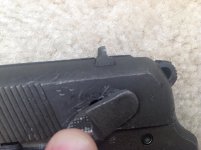It is pretty complicated, not every detail is known, and I finally read the section on post Dec. 1944 production in York's book last night. I have not fully digested it yet so Mike can probably help, or Bob. It is good and some great history there with many documents in German partially translated. My problem with York's book was my expectation to get a good collector guide, which it falls a bit short of IMO, but good in other ways.
The Phosphate guns are all assembled after the factory equipment was moved in late 1944. All are in the second block of serial numbers, at least that is traditional wisdom(a,b,c,d,e,f,g,h,j and k). The majority are in second K block, second most common is second B block, then second A block. The ones outside these blocks are very uncommon, second J block only 4 examples are known last I heard. The ones I have seen are just in a,b,j and K blocks. York says they can be in any of the second blocks. I discussed this with Charlie Wagner just a couple weeks ago at NGD, he usually sets up beside me there. He has seen a few outside my witnessed blocks as York suggests. Obviously they were not all in a series of serial numbers and are spread out. Plus, Mike, with aid of the OP's pistol has shown the last one, or some of the last examples, could be in B block(or any of the known blocks) since there is no final firing proof on the barrel and slide on the OP's pistol. This is something I had never noted. I had always assumed the last pistol would be a K block about 9000 serial number. The highest serial number is near second K 9000.
bnz marked slide examples seem to fall in about second K1000-K2400 serial range. Most bnz slide marked guns are phosphate but a few are blue and I have had one blue example in hand. There are also blank slides(and several other blocks including pre-alpha) in second K with a phospahate finish and one with no slide grip serrations(see Charlie Wagner's display at Tulsa or SCGCA shows if he ever does it again). Typically, a phosphate example will have a 623 on the left trigger guard. I would look very closely if it is missing or seems to be missing, some are poorly stamped but also some late guns have a phosphate finish added and the grips are reproduced, i.e. fakes.
Maybe some others can add and/or correct. It is probably a good idea to do this on Jan's to get the Polish and other "experts" like Kris, Charlie, and others to fill in some holes.
Hope this helps. Interesting pistols for sure.
Thank you for all the information. I agree, these are interesting. I did put this pistol up on Jan's site also. Same user name as here.


